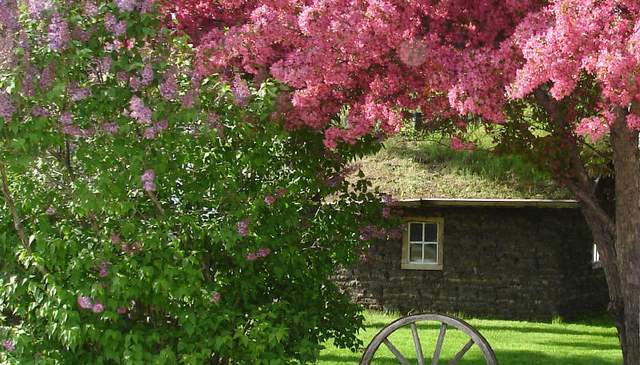| Sod House |
||||
Sod House Goes Up Several Society members went to Edinburg, ND and helped them build their sod house early this fall. Having never built a sod house, they learned much in the process. Edinburg then offered Ox Cart its leftover sod, and even cut it for us. After seven trips to Edinburg and hauling about 20 tons of sod to Drayton, the building materials were ready and the soddy started to “grow” on the lot next to the museum in mid-October. While early settlers used a special plow or sod cutter pulled by oxen to slice strips of sod from the prairie, Edinburg’s people used a skid-steer loader to get that job done. Not only was a back-breaking chore made easier, but the tractor produced nicely uniform sod pieces. Each piece of cut sod is two feet long, one foot wide and four inches thick. The walls are two sod blocks thick, staggered as bricks would be. Every third layer of sod is laid crosswise to tie the inner and outer layers together. All the cracks and holes are filled with loose soil. The sod is laid with the grass side down—21 layers in all. Our sod house is 12 ft. by 14 ft. on the outside, making it 8 ft. by 10 ft. inside. The door and window frames are open boxes the depth of the walls and were set in place so the walls could be built up around the frames. The door and glass windows will be put in place in the spring. Beaver-downed trees were retrieved from the woods and used to support the roof made of one inch-thick oak planks; tar paper and sod will be laid overtop next spring. Sod houses were the first dwellings for many pioneers. The much-needed barn was usually built first; a house would come later. There are only a few written accounts describing the process of building a soddy. The building site on the prairie was first cleared and leveled with a sharp spade prior to building up the walls. Sometimes builders wetted and tamped the entire floor area into a concrete-hard base, or spread cow dung on the floor then tamped that into a concrete-like floor. We did not spread any cow dung. The Red River of the North books by Lauraine Snelling tell of pioneers living in and under their wagons until a soddy could be built on their land. When finished, the sod house was close quarters, but during Dakota winters it was very warm inside. To date the group has spent over 200 man-hours building the soddy; a few more hours will be required to finish it up. Watch for activity on the museum grounds as the weather warms, because we welcome you to join in the fun and unique experience of building an authentic sod house.
|
 |
|
|